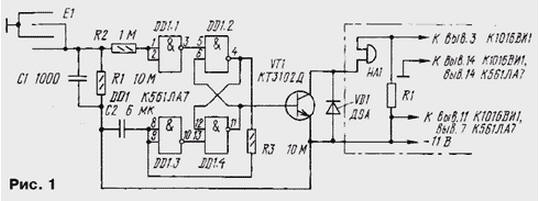Consumer watch "electronics 7-2103", produced by JSC Saratov "Reflector", have a very significant disadvantage. The alarm can be disabled in them keyboard the button is very small in size, extremely inconvenient in circulation. I propose to modify the clock in order to turn off the beep would using the touch sensor.
The revised scheme is shown in Fig. 1. In the initial state, the transistor VT1 is open and prevents the sound signal. When the alarm goes off the user by touching the touch sensor E1, reduces its resistance to 10...100 kω, causing the trigger on the elements DD1.2, DD1.4. The signal of the logic zero from the output of the element DD1.4 will go to the base of transistor VT1 and closes it, the alarm will stop. In its original state the trigger DD1.2, DD1.4 will return after the charging of capacitor C2 through resistor R3 to threshold element DD1.3.

The sensor is made in the form of four spaced parallel to each other the metal plates. Two of them (for example, even-numbered) are connected to the common wire, and the other two connected to the junction point of the resistors R1, R2. For reliable operation of the device the resistance of the gap between the plates should not be below 20 MW.
Attach the plate to watch over Luke for extra batteries. Previously in case you drill holes, the diameter of which depending on the size of fastener plates (Fig. 2). Chip glued to Board hours with BF-2 next to the keyboard. The pins should be facing up. They must bend to them in common with the chip height does not exceed 6 mm When mounting the conclusions perform the function of the mounting posts. Mounting - hinged with any compact resistors and ceramic capacitors. Required capacity last is achieved by parallel switching of several elements. Settings this the device requires virtually no.

If you wish to watch, you can enter the mode "dobucki," i.e., filing a second sound signals within one minute. These signals will be switched off when another the touch sensor. To implement dobucki" should to reduce the value of capacitor C2.
Author: A. Kapustin, Zheleznogorsk, Krasnoyarsk region






